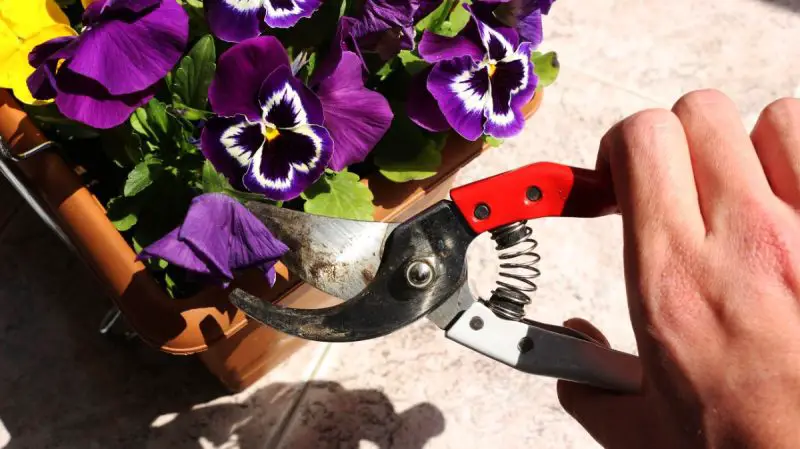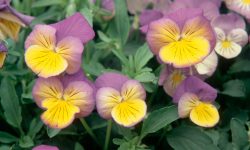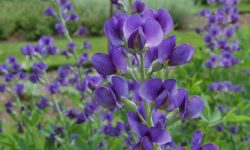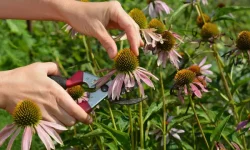Pansies add instant charm to gardens, patios, and containers with their wide range of bright, velvety blooms. These cool-weather favorites light up the landscape from early spring to late fall, offering color when many other flowers fade. Yet as the season advances, even the most vibrant pansies begin to wilt and lose their brilliance. The key to keeping them fresh and blooming continuously lies in one simple gardening practice—deadheading. By removing faded flowers at the right time, you help the plant stay focused on creating new buds instead of forming seeds.
Deadheading pansies is not only about appearance but also about plant health and longevity. Each time you trim spent blossoms, the plant redirects its nutrients toward fresh growth, producing lush foliage and abundant flowers. With regular care and gentle attention, your pansies can reward you with endless waves of cheerful color all season long.
Understanding Why Deadheading Pansies Matters

Deadheading is one of the most valuable yet often overlooked tasks in maintaining pansies. These charming flowers have a natural tendency to channel their energy into seed production once their blooms start to fade. When this happens, the plant believes its life cycle is complete and slows down its growth and flower production. By removing spent blooms before they turn into seed pods, you interrupt that process and redirect the plant’s energy toward producing new buds. This simple act keeps your pansies in a constant state of renewal, allowing them to bloom repeatedly from the start of spring through the cool days of autumn.
Beyond promoting more flowers, deadheading greatly enhances the plant’s health and appearance. Old blossoms tend to trap moisture, especially after rain or heavy watering, which can create a breeding ground for mold, mildew, and other fungal diseases. These issues not only damage petals but can also spread to stems and foliage, weakening the entire plant. By regularly deadheading, you improve airflow around the base, reduce the risk of disease, and ensure that sunlight reaches every leaf. Healthy pansies grow stronger roots, richer foliage, and more vibrant flowers that hold their color longer.
In addition to boosting health and longevity, deadheading helps maintain a compact, well-shaped plant. When pansies are left to grow without pruning, they often become leggy and uneven, losing their neat, full form. Consistent deadheading encourages side shoots to emerge, resulting in a bushier plant covered with more blooms. This routine care transforms your pansy bed or container into a continuous sea of color. Over time, you’ll notice that pansies treated with regular deadheading outperform neglected ones in both beauty and endurance, making this technique essential for any gardener who wants continuous, eye-catching blooms all season long.
When and How Often to Deadhead Pansies
Knowing when and how often to deadhead pansies is the key to keeping them blooming continuously. The best time to start is as soon as the first flowers begin to fade or lose their bright color. Early action prevents the plant from diverting energy into seed production. Ideally, gardeners should inspect their pansies every few days, especially during peak blooming periods in spring and fall. Frequent attention allows you to remove fading blooms before they wither completely. The earlier you catch them, the faster the plant will respond with new buds and fresh blossoms.
Pansies thrive on regular maintenance. If you deadhead only once every couple of weeks, the plant may already have begun forming seeds, slowing its ability to produce new flowers. Checking your pansies two or three times a week is ideal, particularly during warm weather when blooms mature more quickly. After rainfall or strong sunlight, flowers can deteriorate faster, making it even more important to remove them promptly. This steady rhythm of care ensures your plants never miss a chance to renew themselves and stay vibrant.
As the seasons change, your deadheading routine should adjust accordingly. In early spring, pansies produce flowers at a slower rate, so weekly trimming may be enough. By late spring or early fall, when growth accelerates, deadheading should become more frequent. During hot summer spells, when pansies tend to rest, focus more on removing damaged foliage rather than forcing blooms. Paying attention to the plant’s natural rhythm helps you find the right balance, ensuring your pansies stay healthy, full, and colorful throughout every phase of the growing season.
How to Properly Deadhead Pansies
Mastering the correct technique for deadheading pansies ensures that every cut supports healthy regrowth and continuous blooming. Begin by closely examining your plants and identifying the flowers that have begun to wilt, fade, or lose their color. A bloom ready for removal will often appear limp or dry, with petals curling inward. Follow the flower stem down to where it connects with a pair of healthy leaves or a new bud. Using clean garden scissors or your fingertips, snip the stem just above that point. This encourages the plant to send nutrients toward developing buds rather than wasted seed formation. Always remove the entire spent flower head, including the small seed pod that forms beneath it.
The way you handle the plant also makes a difference. Avoid tearing or pinching stems too roughly, as this can damage delicate tissue and invite disease. Sharp scissors or pruning shears provide a clean cut that heals quickly, minimizing stress on the plant. After each session, sanitize your tools with rubbing alcohol or a mild bleach solution to prevent the spread of bacteria or fungal spores between plants. If you prefer a softer touch, pinching with fingers is fine for small gardens, as long as the stem breaks cleanly. The goal is to remove dead blooms efficiently without harming nearby buds that will soon open.
After deadheading, give your pansies a light watering and, if possible, a dose of balanced liquid fertilizer. This extra nutrition helps the plant recover and stimulates new flower development. Within a week, you’ll notice fresh buds forming, often in greater numbers than before. By repeating this process throughout the season, your pansies will reward you with lush growth and waves of colorful blossoms that brighten your garden month after month.
Tools and Materials Needed for Deadheading Pansies
Having the right tools makes deadheading pansies easier, faster, and more effective. The most essential item is a pair of small, sharp pruning shears or garden scissors. These tools allow you to make precise cuts without crushing the stems, helping the plant heal quickly. For smaller gardens or delicate varieties, you can also use your fingers to pinch off faded blooms, but scissors provide a cleaner finish. Keep a small container or garden bag nearby to collect the removed flowers, as leaving them on the soil can attract pests and mold. It’s also helpful to wear lightweight gardening gloves to protect your hands from dirt, moisture, and accidental nicks during the process.
Cleanliness is another important factor in maintaining healthy pansies. Always sanitize your cutting tools before and after use to prevent the spread of disease. A quick wipe with rubbing alcohol or a diluted bleach solution works well. Regular cleaning also keeps blades sharp, ensuring smooth cuts that won’t tear plant tissue. If you notice sticky residue or sap building up on your shears, rinse them in warm, soapy water and dry them thoroughly before the next use. A little attention to tool care goes a long way toward promoting strong, disease-free pansies that continue to bloom beautifully.
You may also want to keep a watering can and a balanced liquid fertilizer nearby when deadheading. Once the faded blooms are removed, watering helps the plant recover, while fertilizer replenishes nutrients lost during flowering. These small but consistent steps make a noticeable difference in plant performance. With the proper tools and routine maintenance, you’ll find that deadheading pansies becomes an easy, satisfying task that keeps your garden full of life and color all season long.
Signs That Your Pansies Need Deadheading
Recognizing when your pansies need deadheading is vital to keeping them in constant bloom. The most obvious sign is the presence of wilted or discolored flowers. As pansy petals age, they lose their vibrant color and begin to curl inward or droop. Some may even develop a papery texture or start turning brown around the edges. These fading blooms indicate that the plant is shifting its focus toward seed production rather than new flower growth. By removing them promptly, you redirect the plant’s energy back to producing buds, ensuring your pansies remain covered in bright, fresh blossoms. Regular observation helps you catch these signs early before seed pods fully form.
Another clear sign that deadheading is needed is a slowdown in blooming. When your pansy bed looks less colorful or shows more green foliage than flowers, it’s often because old blooms are still attached and consuming the plant’s resources. Seed formation demands a lot of energy, leaving less available for producing new flowers. You may also notice fewer buds forming or smaller blooms appearing over time. Deadheading helps reverse this decline by stimulating the plant to generate more stems and blossoms, restoring that lush, colorful display your garden had earlier in the season.
Sometimes, pansies also display subtle signs that are easy to overlook. A general tired appearance, uneven growth, or a stretched, leggy form can all signal the need for trimming. Removing faded flowers encourages compact, tidy growth and prevents the plant from becoming thin or straggly. Even if blooms still appear partially healthy, removing them before they fade completely can prolong the flowering phase. Understanding these small but important signs ensures your pansies stay strong, beautiful, and full of color throughout the growing season.
Common Mistakes to Avoid When Deadheading Pansies
Cutting Too High on the Stem
One of the most frequent mistakes gardeners make when deadheading pansies is cutting too high on the stem. Many people simply pinch off the faded flower head, leaving the small green seed pod still attached. This pod tells the plant that its job is done—it has produced a flower and can now move on to making seeds. Once that process begins, the pansy naturally slows down flower production, leading to fewer blooms and a less colorful garden. To prevent this, trace the flower stem down to where it meets a healthy leaf or an emerging bud, and make your cut just above that junction. This approach signals the plant to keep producing new growth and vibrant blossoms instead of seeds.
Cutting correctly not only prolongs flowering but also improves the plant’s shape and vigor. Pansies that are trimmed properly stay compact, lush, and symmetrical. When cuts are made too high or unevenly, the plant may grow tall and leggy, losing its attractive form. It’s also important to avoid cutting too close to the crown, as this can damage new buds forming beneath the surface. By paying attention to stem placement and cutting with care, you can encourage strong, healthy regrowth that leads to longer-lasting color and continuous beauty throughout the growing season.
Being Too Rough or Inconsistent
Another common error when deadheading pansies is handling the plant too roughly. Pulling or twisting stems with your hands might seem quicker, but it can easily bruise tender tissue or snap nearby buds. These small injuries make the plant vulnerable to fungal infections and pest attacks. To avoid this, always use clean, sharp scissors or small pruning shears to make smooth, deliberate cuts. Wipe your tools with rubbing alcohol before and after use to prevent the spread of disease. After cutting, remove the faded flowers and fallen petals from the soil surface, as decaying plant matter can harbor mold, insects, and harmful bacteria that weaken pansies over time.
Inconsistency is another problem that affects bloom production. Deadheading once every few weeks is not enough for continuous flowering. Pansies thrive on regular attention, especially during peak blooming periods. Checking your plants two or three times a week allows you to remove fading flowers before they drain the plant’s energy. This steady care keeps pansies compact, encourages new buds, and extends their blooming season significantly. By combining gentle handling with consistent maintenance, you’ll create the ideal environment for pansies to flourish, producing wave after wave of fresh, colorful blooms all season long.
Seasonal Deadheading Tips for Pansies
Deadheading pansies throughout the year requires small adjustments depending on the season and climate. In early spring, when temperatures are mild and new growth is just emerging, pansies produce their first flush of flowers slowly. During this time, inspect plants once a week and remove only the most faded blooms. Allowing a few blossoms to mature helps the plant build strength. As spring warms up, flowering becomes more abundant, and deadheading should be done more frequently—every few days if possible. This ensures that the plant channels its energy toward continuous blooming rather than seed production. Early attention during this period sets the foundation for strong, long-lasting growth in the months ahead.
Summer requires a more delicate approach. Pansies tend to struggle in high heat and may enter a semi-dormant phase. Instead of aggressive deadheading, focus on removing only the most wilted or diseased flowers and damaged leaves. This keeps the plant tidy without stressing it further. Providing shade during the hottest part of the day and maintaining even soil moisture can help pansies survive the heat. Once cooler temperatures return, they’ll respond with fresh bursts of color. Avoid overfertilizing or trimming too harshly in midsummer, as this can exhaust the plant and reduce its ability to recover when the weather cools.
As autumn arrives, pansies experience another major blooming period. Cooler air and shorter days create perfect growing conditions, making consistent deadheading essential. Check plants several times a week, removing every spent flower promptly to maximize bud formation before winter. If you live in a region with mild winters, pansies may continue blooming until frost. A light layer of mulch can protect roots from cold damage while keeping the soil moist. With proper seasonal care and attentive deadheading, your pansies will stay bright and full of life through nearly every month of the year.
Best Practices for Deadheading Pansies
Choosing the Right Tools for Deadheading Pansies
Deadheading pansies may look simple, but the tools you use can make a big difference in the plant’s health and blooming potential. Small, sharp scissors or precision pruning shears are ideal choices for cutting faded flowers cleanly. Their fine blades allow you to make smooth cuts without crushing the delicate stems, reducing the chance of bacterial infection or damage to nearby buds. While some gardeners prefer to pinch off blooms with their fingers, this method often leaves ragged edges or tears that may stress the plant. Clean, precise tools help pansies recover quickly and redirect energy into producing new buds instead of healing wounds.
Keeping your tools clean is just as essential as choosing the right ones. Before and after each use, wipe the blades with rubbing alcohol or a diluted bleach solution to remove any pathogens. This practice prevents the spread of fungal spores, especially if you work with multiple plants. During long gardening sessions, it’s helpful to re-clean your tools occasionally to maintain sharpness and hygiene. Proper sanitation ensures each cut remains neat and promotes faster regrowth. With consistent care and the right tools, your pansies will remain vibrant, healthy, and continuously blooming throughout the season.
Identifying and Removing Spent Blooms Properly
Recognizing when and how to remove spent blooms is the foundation of successful deadheading. A fading pansy typically shows wilted petals and a small seed pod developing at the flower’s base. Once the seed pod starts forming, the plant begins to divert energy from blooming to seed production. To maintain continuous flowering, you should remove these blooms as soon as they fade. Use sharp scissors or pruning shears to make a clean cut just above the nearest set of healthy leaves or flower buds. This encourages new growth and prevents the plant from wasting energy on seeds.
Be gentle when handling pansies since their stems are soft and can break easily. Hold the stem steady with one hand and cut with the other to avoid tearing. During warmer months, when pansies bloom and fade quickly, it’s best to inspect your plants every two to three days. Consistent deadheading not only extends the blooming season but also keeps the plant compact and lush. By staying attentive and removing old flowers promptly, your pansies will continue to produce bright, cheerful blooms that refresh your garden for months.
Caring for Pansies After Deadheading
Watering and Feeding After Deadheading
After deadheading pansies, proper watering and feeding become essential steps to support quick recovery and sustained blooming. Pansies thrive best in soil that stays consistently moist yet well-drained. Immediately after removing faded flowers, give the plants a deep, slow watering to help them replenish moisture lost during pruning. Water early in the morning and aim directly at the soil rather than the leaves or flowers. This prevents fungal problems and keeps the roots hydrated without promoting rot. In hot or windy weather, check soil moisture frequently, as pansies can dry out quickly and stop blooming when stressed. Consistent watering encourages strong root systems and ensures a continuous cycle of new buds forming after each deadheading session.
Feeding pansies after deadheading is equally important to keep energy flowing toward new blooms. A balanced, water-soluble fertilizer with equal parts nitrogen, phosphorus, and potassium every two weeks works well. For even more vibrant color, you can switch to a fertilizer higher in phosphorus, which promotes flowering. Avoid heavy feeding with nitrogen-rich formulas, as they encourage leafy growth instead of blossoms. A light dose of compost tea or diluted liquid fertilizer after watering can also give pansies a natural nutrient boost. This steady supply of water and nutrients allows them to recover faster and maintain lush, colorful displays from spring through the end of the growing season.
Protecting and Maintaining Healthy Growth
After each round of deadheading, maintaining the overall health of your pansies ensures that they continue producing vibrant blooms. Start by inspecting the plants for wilted or diseased leaves, which can harbor pests or mold. Removing these damaged parts improves air circulation and prevents fungal growth. Lightly aerate the soil around the base to encourage oxygen flow and root health. During the hottest hours of the day, pansies appreciate partial shade to avoid heat stress, which can shorten their blooming period. A thin layer of mulch around the base not only helps conserve moisture but also stabilizes soil temperature and keeps weeds under control.
Consistent protection from pests and diseases is another key to lasting success. Aphids, slugs, and spider mites are common issues that can weaken plants after pruning. Use neem oil or insecticidal soap regularly to keep infestations in check. After heavy rain, check for compacted soil and ensure proper drainage to prevent root rot. During dry spells, mist the surrounding soil to maintain humidity, which helps keep foliage fresh. Providing this kind of balanced environment allows pansies to recover quickly after deadheading and produce new waves of blossoms. With steady attention, your garden will stay full of color and vitality throughout the season.
Benefits of Regular Deadheading for Pansies
Regular deadheading provides pansies with multiple long-term benefits that go far beyond keeping them beautiful. The most significant advantage is an extended and more prolific blooming season. When old flowers are removed before they begin forming seeds, the plant naturally redirects its energy into producing new buds instead of finishing its reproductive cycle. This process keeps pansies in an active growth phase for months, allowing them to bloom continuously from early spring to the first frost. It also helps maintain a fuller shape, preventing plants from becoming tall, thin, or leggy. Well-maintained pansies look lush and balanced, creating a more appealing display whether they are planted in garden beds, containers, or hanging baskets.
Another major benefit is improved plant health. Spent flowers that remain on the plant can retain moisture and encourage fungal growth, such as botrytis or powdery mildew. These diseases spread quickly, especially in humid or rainy conditions, weakening the foliage and reducing future blooms. Deadheading helps prevent these issues by improving air circulation and light exposure around the plant. Cleaner, drier foliage leads to stronger stems and more resilient plants. It also reduces the number of pests that thrive on decaying petals. Healthy pansies can better withstand changes in temperature, producing richer colors and sturdier blossoms that last longer.
Beyond the physical benefits, deadheading pansies also nurtures a deeper connection between gardener and plant. This small act of care allows you to notice subtle changes in growth, soil moisture, or pest activity before they become problems. It turns maintenance into a relaxing, rewarding ritual that brings immediate visual results. Each time you remove faded blooms, you make space for a fresh burst of color, creating an ever-changing garden full of life. Regular deadheading is both a science and an art—one that rewards patience, consistency, and gentle attention with a garden that thrives from season to season.
How Deadheading Supports Pansy Growth and Energy Balance
Deadheading plays a vital role in maintaining the energy balance of pansies, directly influencing how the plant grows and flowers. Every time a bloom fades, the plant’s instinct is to begin producing seeds. This natural process consumes a large amount of energy, leaving fewer resources available for developing new buds and strong foliage. By removing spent flowers promptly, you stop this energy drain and redirect the plant’s resources toward continuous growth. The result is a cycle of renewal where pansies stay productive, lush, and colorful for a much longer period. Regular deadheading encourages the plant to focus on upward and outward growth, promoting stronger stems and more abundant blossoms throughout the season.
This energy redirection also supports overall plant health. Instead of wasting nutrients on seed formation, the plant can strengthen its root system, which becomes better equipped to absorb water and minerals from the soil. Strong roots help pansies handle environmental stress, such as sudden temperature changes or short dry spells. Deadheading also encourages the growth of new side shoots, leading to a fuller plant with multiple blooming points. Over time, this results in a dense mound of flowers that looks vibrant and uniform rather than sparse and uneven. A consistent deadheading routine ensures that each pansy receives the energy it needs to stay strong and keep flowering beautifully.
In addition to physical growth, deadheading helps maintain the plant’s natural rhythm. Pansies that are regularly trimmed remain in a constant flowering phase rather than entering dormancy too early. This not only extends the blooming season but also enhances the overall garden display. Whether you’re growing pansies in borders, pots, or window boxes, this simple act of removing faded blooms keeps them vigorous, balanced, and bursting with color. The connection between deadheading and plant vitality is undeniable—consistent care directly translates into stronger growth, brighter flowers, and healthier plants all season long.
Common Mistakes to Avoid When Deadheading Pansies
Cutting Too Much or Too Little
One of the most common mistakes gardeners make when deadheading pansies is cutting too much or too little of the stem. Removing only the faded petals while leaving the seed pod attached prevents the plant from redirecting energy toward new blooms. The seed pod signals the plant that it has completed its reproductive cycle, which can slow or even stop flower production. To avoid this, always cut just above the nearest healthy set of leaves or nodes, ensuring the entire spent flower, including the seed pod, is removed. This method encourages new shoots and maintains compact, bushy growth that results in more flowers over time.
On the other hand, overzealous cutting can harm the plant and stunt its development. When too much foliage or stem is removed, pansies lose their ability to photosynthesize efficiently, making them weak and slow to recover. Each leaf plays a vital role in producing the energy the plant needs for continuous blooming. Always use sharp, clean tools to make precise cuts, and avoid trimming healthy leaves unless necessary. By striking the right balance between too much and too little, you’ll keep your pansies strong, productive, and blooming beautifully throughout the season.
Neglecting Cleanliness and Timing
Ignoring cleanliness and timing is another major error that can impact the success of deadheading pansies. Using dirty or dull tools increases the risk of spreading fungal diseases like powdery mildew or bacterial blight. Every cut creates a small wound, which can quickly become an entry point for pathogens if the blades aren’t properly sanitized. Before starting, wipe pruning shears with rubbing alcohol or a diluted bleach solution to eliminate harmful microorganisms. Regular cleaning during your gardening session also prevents sap buildup that can cause uneven cuts. Clean tools not only protect the plant but also help it heal faster and produce new growth more efficiently.
Timing plays a crucial role in how well pansies respond after deadheading. Performing the task during the heat of the day can stress the plant, leading to wilting and slower recovery. The best time to deadhead is early in the morning or late afternoon when temperatures are cooler. Avoid cutting right after watering, as wet stems are more fragile and prone to tearing. Waiting for the plant to dry ensures cleaner cuts and minimizes the risk of rot. With careful attention to timing and cleanliness, you’ll keep your pansies healthy, disease-free, and bursting with fresh blooms week after week.
FAQ About Deadheading Pansies
How often should I deadhead my pansies?
You should deadhead pansies every few days during the blooming season. Regular removal of faded flowers prevents seed formation and encourages the plant to produce more blooms. Frequent deadheading also keeps pansies looking tidy and healthy while extending their flowering period throughout spring and fall.
Can I deadhead pansies with my fingers instead of scissors?
Yes, you can pinch off spent blooms with your fingers if you’re gentle. However, using scissors or pruning shears gives cleaner cuts, reducing the risk of damaging stems or spreading disease. Always wash your hands or sanitize tools before deadheading to protect the plant from potential infection.
Will my pansies stop blooming if I don’t deadhead them?
If pansies aren’t deadheaded, they begin forming seeds, signaling the plant to stop producing new flowers. As a result, blooming slows dramatically, and the plants may look leggy or tired. Regular deadheading redirects energy toward new buds, ensuring longer-lasting, continuous color in your garden.
When is the best time of day to deadhead pansies?
The ideal time to deadhead pansies is in the early morning or late afternoon. During these cooler hours, plants experience less stress, and cuts heal faster. Avoid removing blooms under direct midday sun, as high temperatures can dehydrate the stems and slow recovery.
Can I deadhead pansies during winter?
In mild climates, pansies may still bloom lightly during winter, and you can continue deadheading as needed. In colder regions, however, plants typically go dormant. Stop deadheading once growth slows significantly and resume in early spring when new buds start forming again.
Conclusion
Deadheading pansies is a simple yet powerful gardening technique that transforms ordinary plants into nonstop bloomers. By removing faded flowers regularly and caring for the plant afterward, you help it stay vibrant, compact, and full of color throughout the growing season. With the right tools, proper timing, and attention to detail, pansies reward your effort with a dazzling display of cheerful blooms. Whether grown in garden beds, borders, or containers, consistent deadheading keeps them looking fresh and lively. Embrace this easy practice, and your pansies will flourish beautifully from early spring to late fall.






